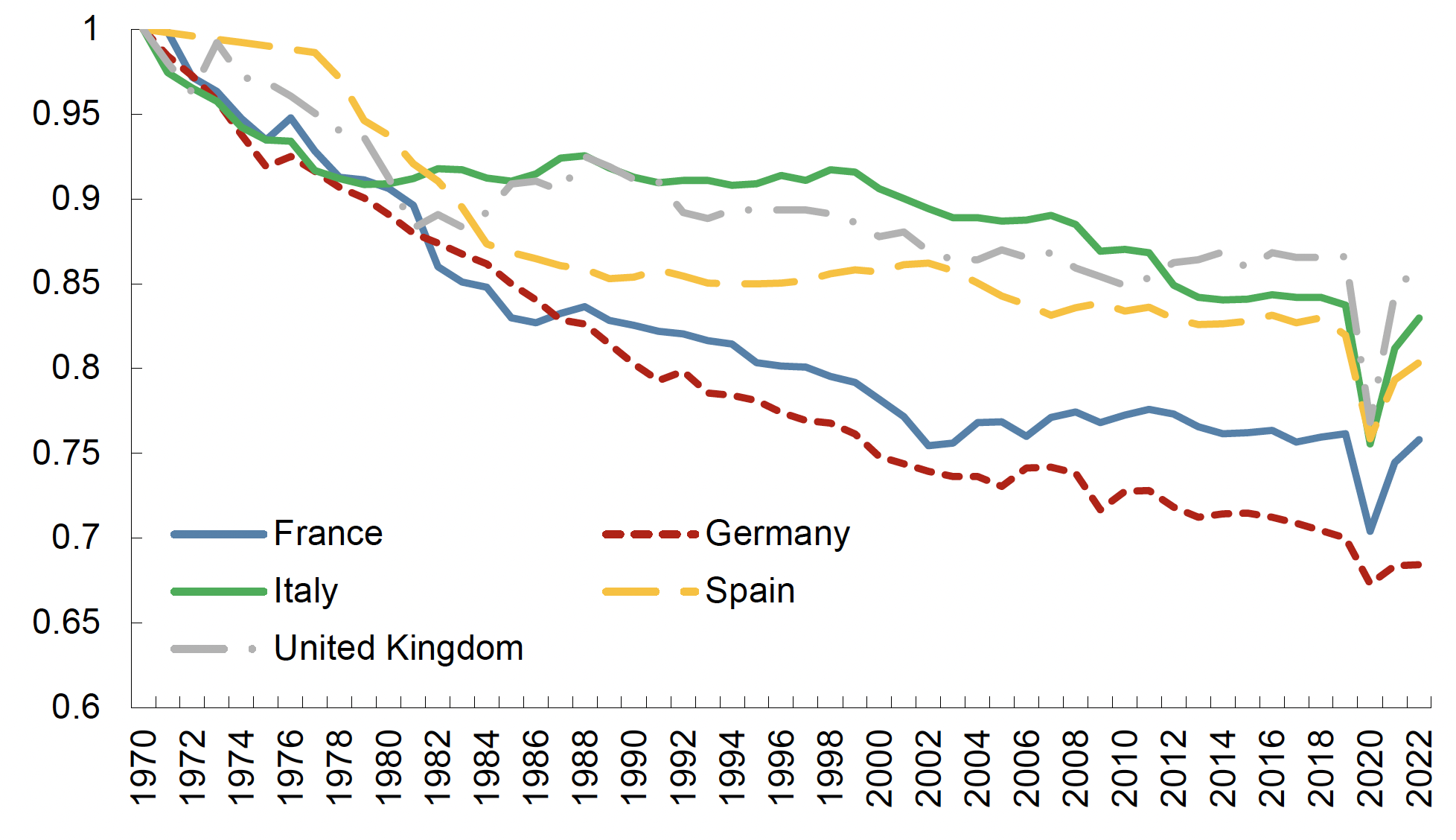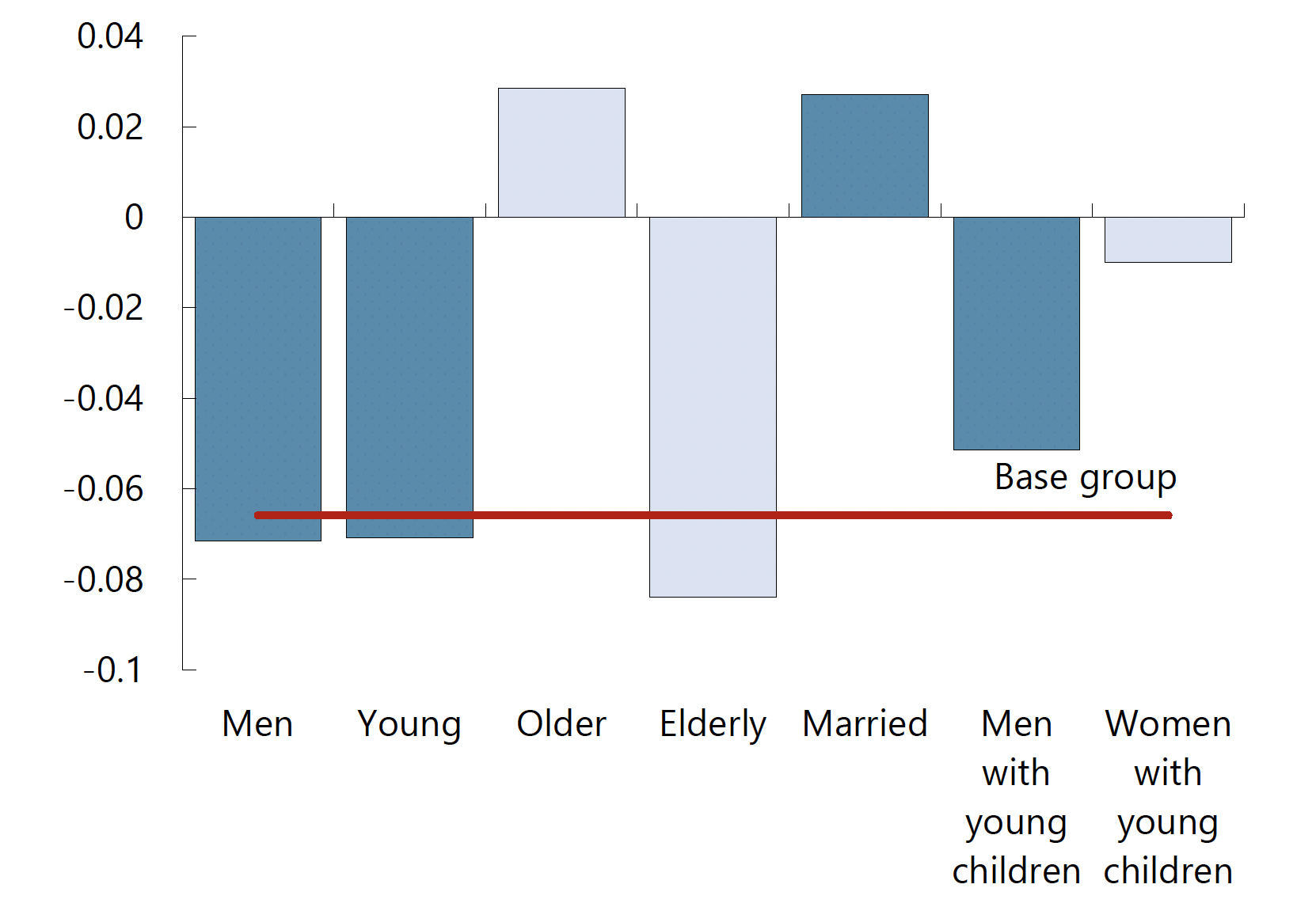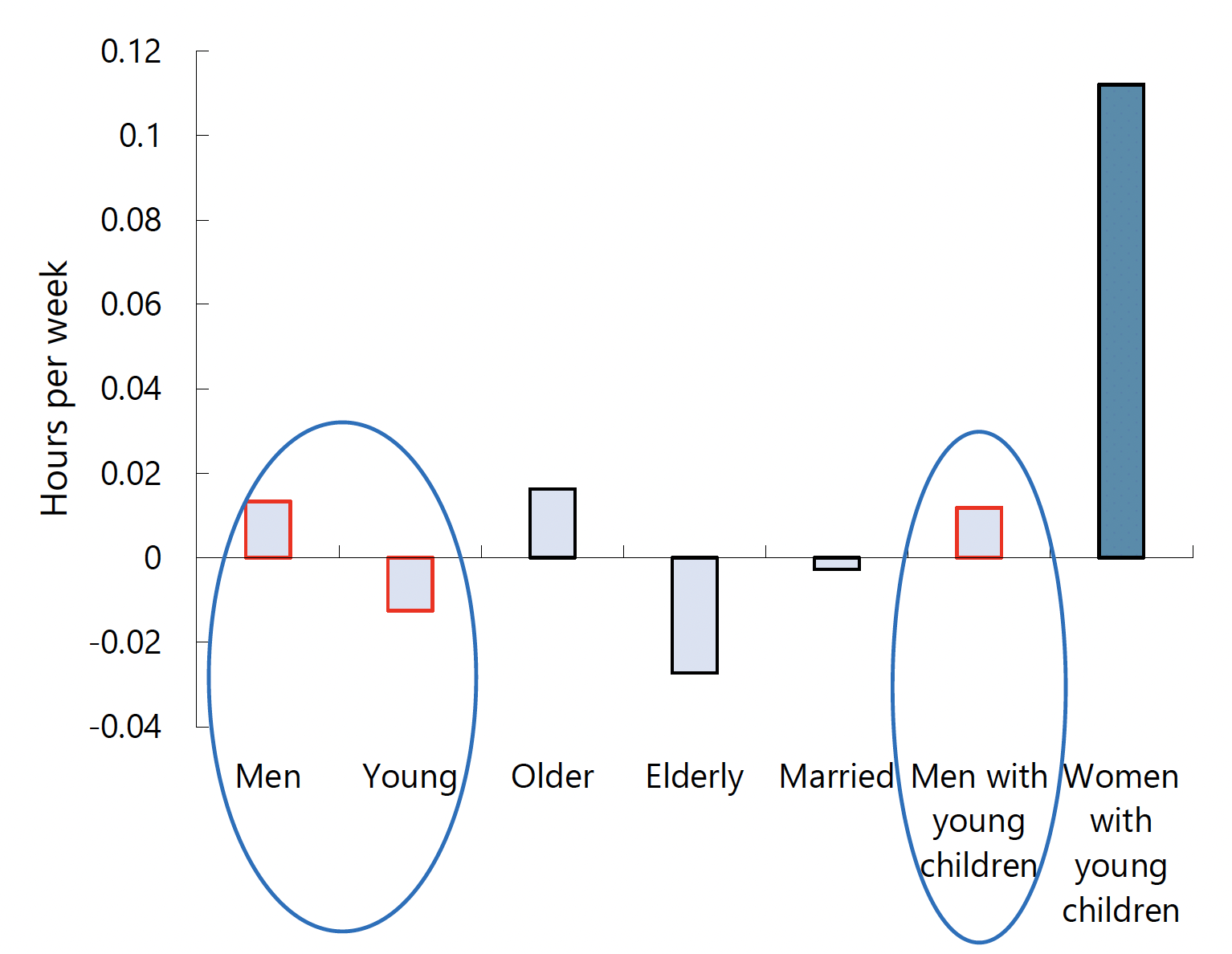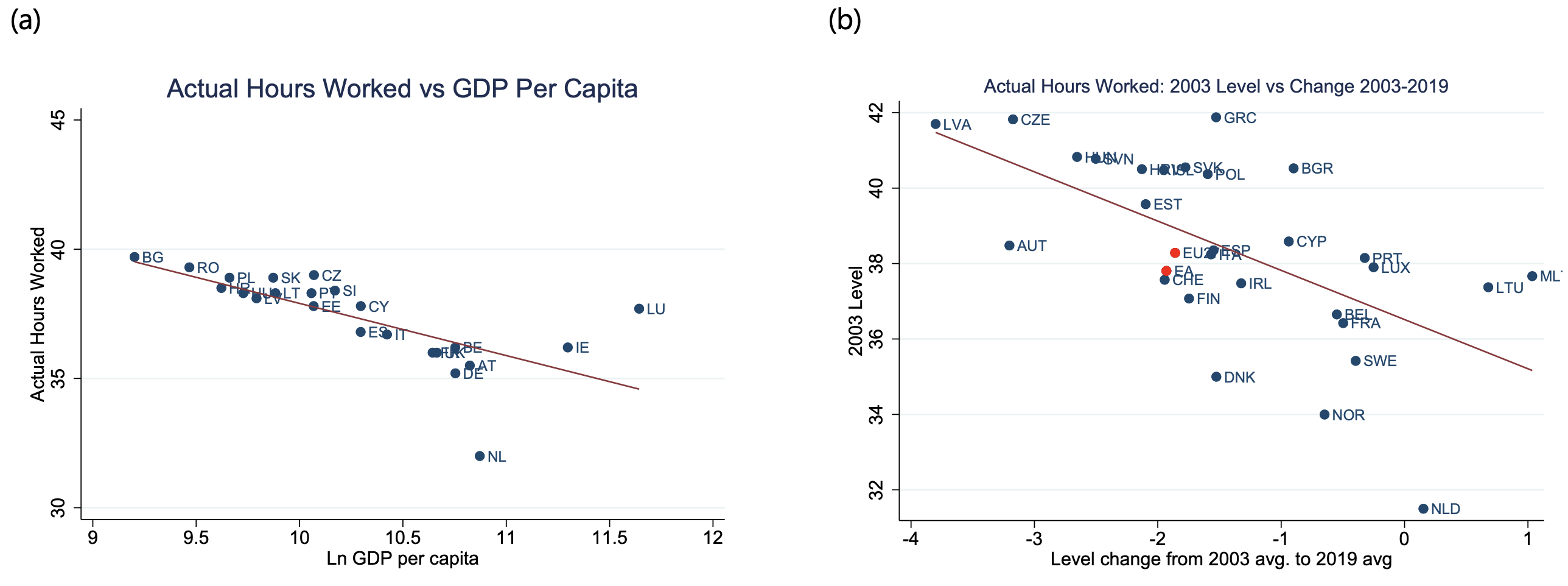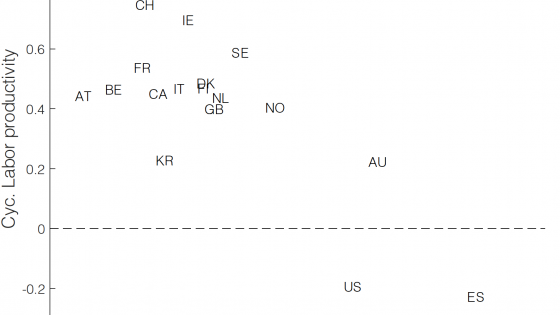European labour markets remained resilient during and after the COVID-19 crisis. By now, total hours worked in Europe have fully recovered, driven by a strong rebound in the employment rate (the extensive margin). However, average hours per worker (the intensive margin) remain below their pre-COVID-19 levels (Figure 1). What explains this remaining shortfall in average hours?
This has been the subject of a lively debate, especially given the widespread labour market shortages in Europe. Arce et al. (2023) argue that increased sick leave has depressed hours in the post-COVID-19 period. The European Commission (2023) reminds us that working hours have been on a long-term declining trend across Europe for many decades.
Figure 1
Note: The figure shows the average hours worked of the median, 25th, and 75th percentile countries of EU27 countries. The line shows the 2019 level of the median country.
Sources: Eurostat and authors’ calculations.
In a new paper (Astinova et al. 2024), we show that working hours in the EU are now back to their downward long-run trend. In other words, little remains of the large cyclical decline in hours observed during COVID-19; while a few factors such as sick leave may still be holding back workers’ hours, the remaining gap vis-à-vis pre-COVID-19 levels is primarily structural. Having documented this fact, our paper then delves into the structural drivers of the long-term downward trend in average hours worked in Europe, and discusses the scope, or lack thereof, for reversal.
The decline in average hours worked is a long-term phenomenon
Figure 2 illustrates the long-term downward trend in average working hours across European countries. The trend is broad-based, albeit with a substantial degree of cross-country heterogeneity. For a deeper dive into this trend, we exploit rich micro data from the EU Labour Force Survey for 2003-2019 – a period over which the decline was milder than its earlier trend, but that can be analysed in greater depth thanks to available granular micro data.
Figure 2 Average hours worked: Long-term trend (index, 1970=1)
Source: OECD.
The drop in hours is widespread across demographic groups
A first natural question to ask is whether the observed decline was driven by a change in the composition of employment – such as a shift in jobs towards occupations where part-time work is pervasive, for example in retail trade – or whether it was instead broad-based, with most worker groups having reduced their hours. The data firmly suggest the latter, as shown in the decomposition of the overall decline in hours worked into between- and within-group components (Figure 3). While compositional shifts towards workers or jobs with shorter hours have played some role, the decline in average hours worked since 2003 has been widespread across demographic groups, industries, and occupations.
Figure 3 Between and within decomposition
Note: Figure 3 shows the between and within decomposition of the total change in average hours worked. “By Demographics” shows the decomposition for 2003-2019 using the cross-product of 32 groups: 2 gender × 4 age groups × 2 marital status × young child dummy. “By Industry” shows the decomposition for 2008-2019 using 21 industry categories. Lastly, “By Occupation” shows the decomposition for 2011-2019 using 9 occupation categories.
Sources: EULFS and authors’ calculations.
Young men and specifically young men with children are key groups behind the decline
Looking into which demographic groups contributed the most to the decline in average working hours, young men and men with young children appear to have played a key role (Figure 4). For the young, an increased incidence of part-time workers due to education can explain the decline. For men in general, including those with young children, the decline cuts across full-time and part-time workers and stems from a broad downward shift in the distribution of hours worked. This finding is consistent across European countries.
Figure 4 Annual change in hours worked between 2003-19 (hours per week, deviation from base group’s trend)
Note: Figure 4 shows the deviations of annual change in average hours worked between 2003-19. The base group is prime-aged unmarried women without young children.
Sources: EU-LFS and authors’ calculations.
The decline in actual hours worked largely matches worker preferences
To understand better why most workers have been putting in fewer hours, differentiating between actual, usual, and and desired hours worked can help. Actual hours determine a worker’s labour input in a given week, usual hours reflect normal hours within a working week, and desired hours measure the number of hours survey respondents would like to work. A negative gap between actual and usual hours would typically be due to holidays and parental leave, etc. A negative gap between actual/usual and desired hours would suggest workers want to work longer hours than they actually/usually do.
Comparing trends in these different hours categories suggests that the decline in actual hours has been largely in line with changing preferences. Desired hours have fallen in tandem with actual hours for youth and men, including those with young children – that is, without increasing the gap between desired and actual hours (Figure 5). Only one group, namely women with young children, has seen a widening gap between actual and desired hours worked. At first sight, this might seem to suggest that some of the fall in their hours worked was involuntary. However, the gap between their usual and desired hours has not widened – actual hours have simply dropped relative to usual hours due to increasing take-up of maternity leave, again presumably mainly in line with preferences.
Figure 5 Trend in gap between desired and actual hours (with respect to base group)
Sources: EU-LFS and authors’ calculations
Some scope, albeit limited, for policy interventions
These findings suggest there are few low-hanging fruits for policymakers to boost average working hours – there is no case for attempting to reverse a trend that primarily reflects workers’ preferences. One notable exception is involuntary part-time workers, including women with young children, who would like to work longer hours but are unable to do so. Reducing tax disincentives to working longer hours, training programmes, and expanded childcare could all help these workers raise hours worked towards their stated desired levels. However, even if this gap could be closed in full, the overall impact on average hours worked would be 0.5%-1.5% at most at the EU level – reversing only about one-fifth of its decline over the last two decades.
Looking ahead – no reason to expect a turnaround in the trend for average hours
Looking over the longer term, future income growth is likely to be a key driver of the trend in hours worked (see e.g. Bick et al. 2018). Figure 6a illustrates this conjecture for European countries, while Figure 6b shows how income convergence might lead to hours convergence across Europe – countries that had longer average hours worked per worker two decades ago saw sharper subsequent declines in average hours worked. These facts are consistent with the dominant role of the income effect over the substitution effect in determining workers’ labour supply at the intensive margin (Boppart and Krusell 2020).
Figure 6 Cross-country evidence on hours worked
Note: Figure 6a plots the actual hours worked against log GDP per capita in 2019 in our sample in EU-LFS where actual hours worked are based on EU-LFS micro data, and GDP per capita is from IMF World Economic Outlook database. Figure 6b plots the average hours worked level in 2003 against its change between 2003 and 2019 by country based on Eurostat database.
Sources: EU-LFS, Eurostat, IMF World Economic Outlook, and authors’ calculations.
Given Europe’s modest projected GDP per capita growth rates over the medium term, the most likely scenario is therefore one of continued, but flatter, trend declines in average hours. This broad European outlook likely masks heterogeneity across countries, as the scope for drops in average hours is larger for countries that are farther from the technological frontier and projected to keep growing faster in the future.
Conclusion
This column presented five stylised facts, one implication, and one conjecture about the decline in average hours per worker in Europe. First, the decline is not cyclical but predominantly structural, extending a long-term trend that predates COVID-19; there is, at most, little remaining slack at the intensive margin in Europe. Second, the long-run downward trend of average hours worked does not reflect a shift in the composition of employment towards lower-hours jobs (such as in retail) and workers (such as women with children). Third, men – particularly those with young children – and the youth have seen particularly large trend declines and driven the overall drop in average hours. Fourth, the observed decline in actual hours matches workers’ desired decline – in other words, the decline has largely aligned with worker preferences. Fifth, the only notable remaining gaps between desired and average hours worked are observed for involuntary part-time and women with young children. Policy reforms could help involuntary part-timers and women with young children boost their hours, although such policies could raise average hours by 0.5%-1.5% at most.
Looking ahead, with the trend of declining average hours worked unlikely to revert and with intensifying demographic pressures, any growth in European labour input would need to come from other margins. These primarily include immigration and labour force participation rates, both of which are partly shaped by policies.
References
Arce, O, A Consolo, A Dias da Silva, and M Mohr (2023), “More jobs but fewer working hours”, ECB blog.
Astinova, D, R Duval, N-J H Hansen, B Park, I Shibata, and F Toscani (2024), “Dissecting the decline in average hours worked in Europe”, IMF Working Paper 2024/2.
Bick, A, N Fuchs-Schündeln, and D Lagakos (2018), “How do hours worked vary with income? Cross-country evidence and implications”, American Economic Review 108(1): 170–99.
Boppart, T, and P Krusell (2020), “Labor supply in the past, present, and future: A balanced-growth perspective”, Journal of Political Economy 128(1): 118–57.
European Commission (2023), Labour market and wage developments in Europe annual review 2023.







